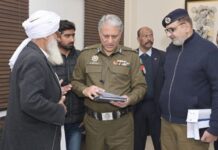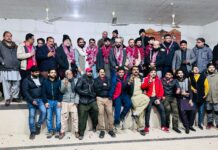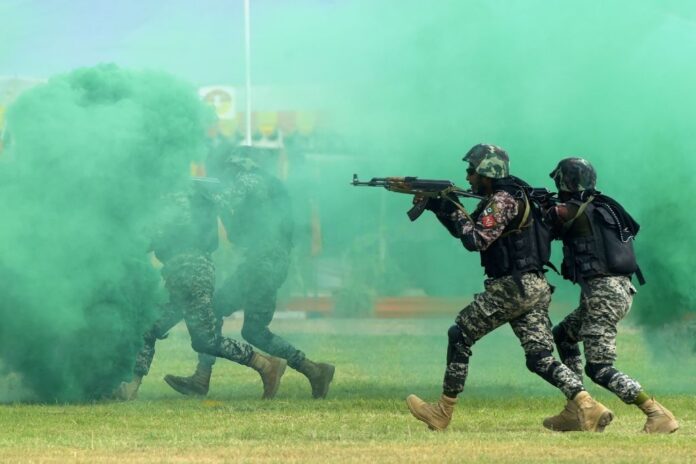Swayed by its military might and abhorrence for a peaceful neighbour, Indian guns roared and fighter jets took on sorties amidst advancement by Indian ground troops aspiring to capture Pakistan’s bordering city of Lahore by the fall of night.
The wee hours September 06 attack on Burki, Kasur and Chowinda sectors was massive, driven by India’s desire for kneeing down Pakistani forces within hours and capturing important cities within a day.
But, they never knew that they had challenged a nation endowed with the passion of martyrdom and defence of their motherland till the last drop of blood.
The countrymen had woken up perplexed listening to firing voices when the clarion call of Field Marshal Ayub Khan touched their ears, “India has attacked Lahore and Pakistan is at war” and around 100 million Pakistanis responded with faith and belief to their General’s call.
The spirit of nationalism surged and around a 100 million brave dwellers of The Land of Pure (Pakistan) manifested purity of their faith and bravery to thwart Indian aggression making the enemy to eat dust just in a few hours resistance.
“It was an astonishing day. We woke up with the roar of fighter jets,” said Abdur Razzaq Malik, a 61-year old citizen, who had witnessed the War of September 1965 as a minor.
“In this perplexing moment, people had gathered at our home to know the updates on the situation at the only radio in whole vicinity when the voice of President Ayub Khan resounded warning India of a lesson learning defeat,” Razzak said.
Recalling the sounds of Pakistani fighter jets rising to the skies to defeat the cowardly enemy, Razzak said as soon as the President’s speech ended the people started chanting slogans of Allah-o-Akbar (Allah is the greatest) and resolved to fight the enemy till its defeat.
When Pakistan’s valiant forces were fighting with the enemy on war front, the nation was busy in digging trenches, preparing food packets for soldiers and boosting their morale with invaluable support.
The whole nation stood united with singers, writers, intellectuals, civil bureaucracy, railway personnel, the police and students playing their due role. Ex-servicemen rushed to recruiting centers for presenting their service to fight on the front as singers galvanized the nation with patriotic songs. Shopkeepers generously donated daily use items for the soldiers fighting on the front.
Pakistani women including Girl Guide movement and All Pakistan Women’s Association collected funds, arranged blood donation camps and offered services to the medical corps as nursing volunteers.
Students and young people thronged the roadsides to provide food, water and other edibles to their troops. Many flocked to Army Centers to offer their services in the war efforts like digging trenches and joining civil defense force.
Indian Army’s assurance to its government of capturing Lahore by the evening dashed to ground after stiff resistance on Burki, Chowinda and other major fronts.
“The Indian claims of their victory in war were bogus. On ground, there was no evidence to support Indian claims,” an American Radio Service Journalist Rai Milan, who witnessed the 1965 war, had recorded in his published-diary report.
“However what I saw was only destroyed Indian tanks and huge logistic support units rolling towards their forward area,” he wrote. “During my two decades journalistic career, I had never seen such brave, victorious and confident fighting soldiers like the Pakistan Army.”
While the findings of the Indian government’s documents termed India’s 1965 attack on Pakistan a blunder of their intelligence and the field commanders, Pakistani side praised morale, bravery and unity of its forces and the nation.
“The Pakistan Army, with high morale and backing of the entire nation, stood like an iron wall against Indian onslaught on all fronts,” remarked defence analyst Lt Gen (retd) Naeem Khalid Lodhi on the 17-day 1965 war.
“We taught them a lesson as on the Sialkot front, one Indian infantry, one armoured division and an armoured brigade were repulsed by a single infantry division of Pakistan,” he said. “Only at Chawinda-Philora sector, 15 Indian attacks were repulsed.”
India had also faced humiliations at Burki sector where 13 of its attacks were completely repulsed, Khalid Lodhi said. “On Kasur front, Pakistan repulsed multiple Indian attacks and captured substantial territory deep inside India.”
He said despite numerical superiority, the Indians were humiliated on all fronts at sea, air and ground. “Everybody knows well the skills of M M Alam (the Little Dragon) who downed five Indian jets in less than a minute time out of total nine struck down by him during the war.”
Similarly, on Sept 8, 1965, the Pakistan Navy warships including its submarine Ghazi raided Dwarka and bottled up the entire Indian Navy fleet, Lodhi told.
Hasan Bhatti, a close relative of Major Aziz Bhatti Shaheed (NH) from Gujrat, recalled that Aziz Bhatti confronted and engaged enemy’s army for five days and nights to defend strategic Bambanwala-Ravi-Bedian (BRB) Canal.
“Undaunted by constant fire from enemy’s tanks and artillery, Aziz Bhatti successfully defended the canal,” Hasan said.
India’s dream of capturing Lahore was doomed to die in presence of the brave sons of soil like Major Aziz Bhatti Shaheed who were endowed with a passion of embracing martyrdom for defence of the country and the nation.
The six times bigger army had suffered a humiliating defeat on all fronts at the hands of gallant Pakistani soldiers, officers, pilots and sailors who proved to the world that they were ever ready to defend every inch of their homeland. This saga will continue to shine through the pages of history and the nation will always feel pride for its brave sons.























